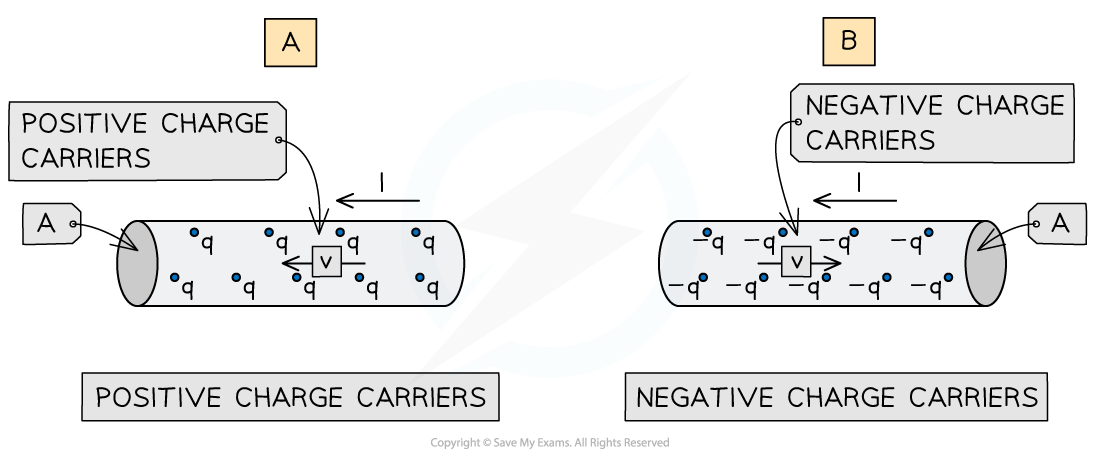Calculating Current & Drift Velocity (Edexcel International A Level (IAL) Physics): Revision Note
Exam code: YPH11
Calculating Current & Drift Velocity
Drift Velocity
In a conductor, the current is due to the movement of charge carriers
The charge carriers can be negative or positive
However current is always taken to be in the same direction
Drift velocity is the average velocity of the charge carriers travelling through the conductor
In conductors, the charge carrier is usually free electrons
Free electrons only travel small distances before colliding with a metal ion
Therefore they have a relatively slow drift velocity of ∼ 10−3 m s−1
In the diagram below, the current in each conductor is from right to left
In diagram A (positive charge carriers), the drift velocity is in the same direction as the current
In diagram B (negative charge carriers), the drift velocity is in the opposite direction to the current

Conduction in a current-carrying conductor
The density n represents the number of free charge carriers (electrons) per unit volume
Conductors, such as metals, have a high value of n
Insulators, such as plastics, have a low value of n
Since the density of charge carriers is so large in conductors, the flow of current flow appears to happen instantaneously
The Transport Equation
The current can be expressed in the transport equation:
Where:
I = current (A)
n = number density (m−3)
q = the charge of the charge carrier (C)
v = drift velocity (m s−1)
A = cross sectional area of the wire (m2), calculated using A = πr2
The same equation is used whether the charge carriers are positive or negative
A negative value for v will indicate current in the opposite direction to the charge carriers
The transport equation shows that v is inversely proportional to n
Since the more charge carriers available per unit volume the more the density will slow down their speed through the conductor
The transport equation also shows that I is directly proportional to n
Greater n means a greater charge is flowing and therefore a larger current I
When the value of n is lower, the charge carriers must travel faster to carry the same current
Worked Example
The number density of conduction electrons in a copper wire is 9.2 × 1028 m−3. The wire carries a current of 3.5 A and it has a cross-sectional area of 1.5 mm2.
Determine the average drift velocity of the electrons.
Answer:
Step 1: Consider the situation
A copper wire is a conductor, and the free electrons are charge carriers
Use the transport equation I = nqvA
Step 2: Rearrange the equation for drift speed v
Step 3: Substitute in values
Current, I = 3.5 A
Cross-sectional area, A = 1.5 mm2 = 1.5 ÷ 10002 = 1.5 × 10−6 m2
Number density of conduction electrons, n = 9.2 × 1028 m−3
Charge on an electron, q = 1.60 × 10−19 C (From the data sheet)
m s−1
mm s−1 (2 s.f.)
The Large Range of Material Resistivities
Resistivity
The transport equation tells us that current, I ∝ number of charge carriers, n
Therefore, the larger the number of charge carriers, the greater the current will be for the same applied voltage
This is because resistivity has decreased with more charge carriers available
Different materials have different numbers of charge carriers
Insulators have few charge carriers:
They have such a high resistivity that virtually no current will flow through them
A perfect insulator would have no charge carriers, n = 0
A perfect insulator would have a current of zero regardless of the voltage applied
Conductors have a large number of charge carriers
Metals are good conductors because they have free electrons
Free electrons are the atoms from the outer shell of each atom
Therefore there are lots of charge carriers per unit volume
This means resistivity is low
Semiconductors have a small number of free electrons
There are fewer delocalised electrons in a semiconductor than in a metal
There are a greater number of free electrons at a higher temperature
Resistivity changes in a semiconductor, due to the variation with temperature in free electrons which are available as charge carriers
Silicon is an example of a semiconductor

The resistivity of some materials at room temperature
Examiner Tips and Tricks
Remember that the cross-sectional area is in m2, the drift velocity is in m s-1 and the number density is in m-3.
Therefore, sometimes unit conversions from cm or mm may be required, so make sure you're comfortable with these.

Unlock more, it's free!
Did this page help you?